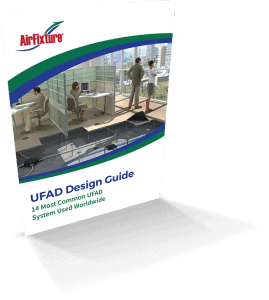Sustainable Office Buildings: 7 Ways UFAD and Raised Floors Can Help the Environment
The demand for environmentally-sustainable buildings is growing exponentially. The number of LEED-registered projects in the United States rose...
Floor, wall and ceiling mounted to meet your unique project design.
3 min read
Joe Hullebusch : Jun 19, 2018 12:00:00 AM

For buildings with large interior spaces, such as event facilities, arenas, auditoriums, and other high-volume enclosures which typically house a large number of people at a time, ensuring that occupants enjoy a comfortable environment is critical. In fact, there’s a known correlation between poor indoor air quality (IAQ) and thermal comfort levels associated with ‘sick building syndrome’ and a building’s operating costs, with some studies suggesting that reducing these symptoms can result in estimated annual savings of between $17 billion and $26 billion to the economy.
Beyond the economic and health benefits, improving occupant comfort is good business, as visitors will be inclined to stay longer while employees will see improved productivity. As a result, more and more facilities are realizing the occupant comfort benefits that UFAD brings.
One of the big benefits of UFAD is that airflow is delivered close to the occupants. Rather than letting the air mix higher up in an overhead system, UFAD allows fresh air to flush particulates while making it easier to reach the lower occupancy zones. This is measurably demonstrated to deliver an IAQ ventilation effectiveness that meets ASHRAE standard 62.1
Underfloor air delivery has the effect of acting like a displacement piston, introducing the fresh air and pushing out older and contaminants rather than simply mixing it together.
So for buildings such as schools, libraries, office buildings, conference rooms, auditoriums, and the like, UFAD delivers a much better indoor air quality. Casinos are especially vulnerable to particulate contamination as they are among the few public places in the United States that still typically allow smoking indoors. With UFAD, however, because fresh air is delivered close to the occupant and gets pushed up, the smoke tends to rise along with it instead of reaching other patrons.
Another advantage of UFAD comes in the form of ventilation effectiveness, or how easily the airflow moves through the occupied space. To meet ASHRAE standards, a typical overhead system uses a modifier of 0.8 against the required cubic feet per minute (CFM) airflow measurement. For example, to deliver a required airflow rate of 100 CFM, that target numer would be multiplied by 0.8 to give an actual ventilation of 80 CFM once duct resistance and other factors are accounted for. This effectively means that an overhead system loses 20% efficiency off the top, so the engineers would have to build the system to handle 125 CFM just to meet the 100 CFM code.
UFAD, by comparison, has a positive CFM modifier of 1.2. So under the previous scenario, to deliver a 100 CFM ventilation target, you would only have to design your system to handle 83 CFM.
These energy savings are usually because UFAD requires considerably less ductwork, which causes air resistance that needs to be overcome by more powerful fans that consume more energy. UFAD is capable of improved ventilation effectiveness with much less energy - in the form of fan horsepower - needed to overcome the air resistance inherent in overhead systems.
For the building owner, this means:
With an overhead system, air is introduced at the top layer of the space; therefore, conditioned air needs to be introduced with enough energy to force its way down to the occupied levels. This essentially means that you are paying to condition the entire air volume of the environment.
However, since UFAD introduces air to occupants from the bottom of the room, you are only required to condition the lower levels of the space, saving you considerable amounts of energy that would ordinarily be wasted heating and cooling air above the occupied zone.
With UFAD’s unique design, airflow is introduced into a space or room from the bottom and collected at the top, allowing you to take advantage of airflow dynamics and convection forces. Your energy costs will be limited to heating or cooling air to a height that’s actually occupied, while your occupants can enjoy easier access to fresh air that pushes away particulate contaminants such as smoke.
AirFixture is a recognized industry leader providing innovative underfloor air distribution products and solutions for office buildings, casinos, event spaces, and government facilities around the world. Contact us today to speak to a UFAD expert and learn how this revolutionary system can deliver unrivaled air quality and significant energy and operational cost savings to your facility.
The demand for environmentally-sustainable buildings is growing exponentially. The number of LEED-registered projects in the United States rose...
There has been a remarkable rise in the number of new building projects which have or plan to use a raised access floor (RAF) and underfloor air...

As one of the leading health issues globally, indoor air pollution poses a very real environmental health concern to home and building occupants -...